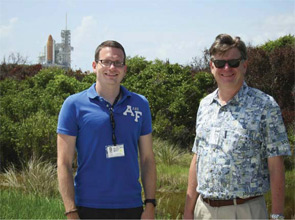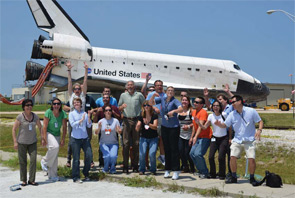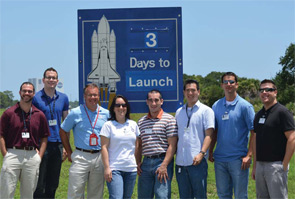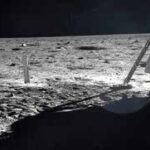Ten years from now, the final flight of the space shuttle Atlantis could very well have a footnote in the annals of bone density research.
The July 2011 trek, the last scheduled shuttle mission for financially hamstrung NASA, took 30 mice into space to give medical researchers a chance to study not only the effects of microgravity on bone density in astronauts, but to glean insights that could help rheumatologists and their patients deal with age-related bone loss in Earth-bound patients. Half of the mice were treated with a sclerostin antibody that pharmaceutical firms Amgen and UBC are co-developing with the intent to help treat osteoporosis in the future. The other half of the rodents was given a placebo.
Why Space?
Ted Bateman, PhD, associate professor in the department of biomedical engineering and department of radiation oncology at the University North Carolina, Chapel Hill, says space flight gives scientists insights they otherwise could not attain. The work done aboard Atlantis was led by seven principal investigators, including Dr. Bateman, Amgen, and researchers at the University of Colorado and Harvard University.
“The benefits of space flight are that it’s an extreme model for causing osteoporosis,” he says. “It’s really not possible to mimic it in any way here on Earth. We have models … but there’s really no way to fully unload the skeletal system on Earth. Even in bed, gravity is affecting the person.”
But not in space, where microgravity and its effects on bone density have been part of NASA space flights for at least a decade. By some estimates, astronauts lose up to 2% of bone density per month in space, giving a sense of urgency to medical experiments on space flights. The research, largely unknown and unheralded outside medical circles, has long been an ancillary benefit of space travel. And so it was after Atlantis’ final flight that researchers were able to dissect the subject mice and study how microgravity affected various bone growth processes. The mice were studied for a variety of other space effects as well, as scientists from a variety of medical specialties arranged to dissect the mice for tissue and other biological material that could be used to forward research.
You always want to move forward in science…and this would be a pretty big step backwards if we can’t fly animals to space again.
Henry Donahue, PhD, vice chair for research in the department of orthopedics and rehabilitation and director of the division of musculoskeletal sciences at Penn State Hershey College of Medicine, Hershey, Pa., led a team that removed marrow from mice bones in an attempt to isolate mesenchymal stem cells that might turn into osteoblasts.
“Our hypothesis [is] that the ability of mesenchymal stem cells to turn into bone-forming cells is decreased in mice that are exposed to microgravity in flight,” he says. “We’ll look at several genes that regulate stem-cell differentiation to bone-forming osteoblastic cells. We might identify a gene, the expression of which is decreased because of microgravity. That could lead to a target to treat osteoporosis.”
The process may take years, just as the development of Amgen’s denosumab medication, which Dr. Bateman helped assess during a shuttle flight 2001 and which received U.S. Food and Drug Administration (FDA) approval for osteoporosis treatment last year (see “From Idea to Approval,” p. 50, for more information on how denosumab was studied in space). In a similar way, Dr. Bateman says the sclerostin antibody tested aboard Atlantis could ultimately be a “fundamentally different type of therapy than what exists to treat osteoporosis right now.” Currently, most therapies prevent bone resorption by tamping down osteoclast activity. Blocking sclerostin could help spur bone formation.
“It may not sound very thrilling, but being able to examine in an environment where bone formation and bone resorption are moving in the opposite direction is extremely valuable from a scientific point of view,” Dr. Bateman says.
Long History of Medical Research in Space
As a researcher, Dr. Bateman is a “veteran” of four NASA flights. On the most recent mission, the mice were stored in NASA-developed cages that fed and provided water for the animals, as well as ensuring proper waste disposal. A control group of mice was in place both on the shuttle and on the ground to provide baseline measurements.
Julie Robinson, the International Space Station program scientist at NASA, says that, while the federally funded agency is no longer running shuttle missions, medical experiments will likely continue via cargo transportation flights operated by other countries and two new commercial flight companies, SpaceX and Orbital Sciences Corp. Both of the private firms are running test flights, with another demonstration trip planned in the coming months.

“Instead of NASA having to build the vehicles to deliver things to the space station, now it’s going to be a little more like UPS where we can order the cargo delivered that we need,” Robinson says. “So we’re working with both of those new cargo providers to help us in providing all different kinds of experiments that we’ve done historically in the past…we essentially don’t have any change in the capabilities of the kind of research we can do.”
Bone researchers are cautiously optimistic that is the case, as space travel can produce insights and medical advancements that otherwise might not happen, particularly important for the astronauts subjected to the biological rigors space inflicts on the human skeletal system.
“If we want to continue space exploration, bone loss and muscle atrophy are going to be a huge problem,” Dr. Donahue says. “So these types of studies will be absolutely critical.”
The value of past shuttle flights—and the medical experiments that piggybacked along for so many of them—extends even further than that, adds Dr. Bateman.
“It would be pretty painful to watch NASA or America not be able to fly experiments like this in the future,” he says. “You always want to move forward in science … and this would be a pretty big step backwards if we can’t fly animals to space again.”
Richard Quinn is a freelance writer based in New Jersey.
From Idea to Approval


Researchers in bone density have long hitched rides on NASA shuttle flights to the International Space Station to conduct medical experiments in space. The fruits of that labor may take years to realize, but scientists say the ends are well worth the means, even if the process can span a decade or more. Take the example of denosumab, an Amgen therapeutic approved by the FDA for multiple uses in treating bone diseases last year—nine years after a space flight where the drug’s research began.
December 2001: The space shuttle Endeavour carries 24 female mice, some of which were given osteoprotegrin (OPG) to test the protein’s efficacy in reversing decreases in bone formation.
June 2010: The FDA approves the first use of denosumab, a RANK Ligand inhibitor developed by BioServe Space Technologies and Amgen Inc., using the research done aboard Endeavour. The FDA clears the injectable drug, known as Prolia, for postmenopausal women at risk of bone fractures because of osteoporosis and other factors.
November 2010: The FDA further clears the use of denosumab, via subcutaneous injections, for the prevention of skeletal-related events in patients with bone metastases from solid tumors.
“It’s really a multiyear process from the original results that will have line of sight on the space station and then all of the work that it takes back on Earth to turn that into a product,” says NASA’s Robinson.

